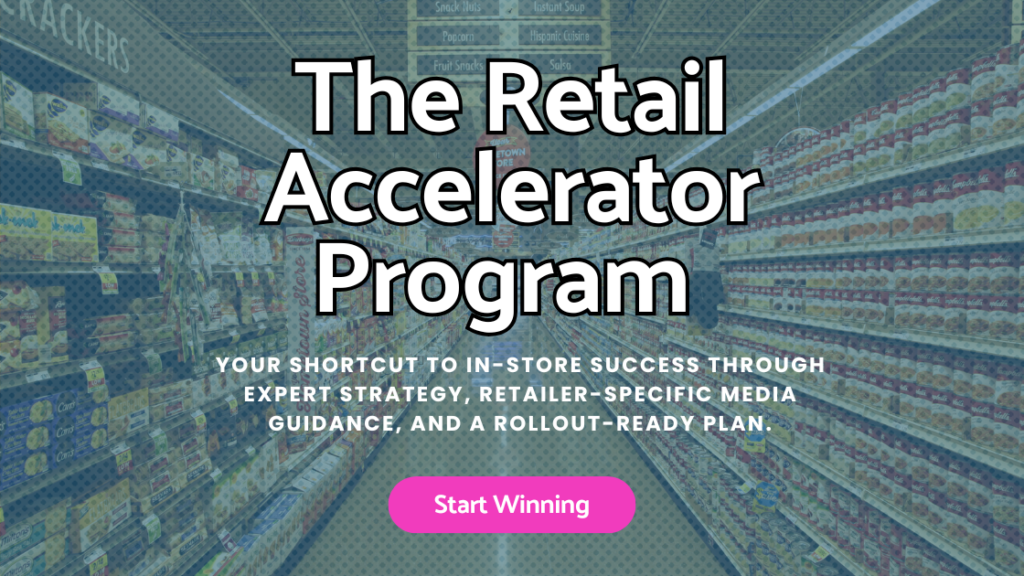Shopper Marketing Strategy: A Guide for CPG Brands
Looking to boost retail sales and engage consumers at key points in their buyer’s journey?
This guide reveals how CPG brands can leverage shopper marketing to do just that. Developed by Cliffedge Marketing—a leader in shopper marketing with over 20 years of experience—this resource provides actionable strategies to optimize your marketing plan using data-driven insights. Whether you’re revamping an existing strategy or starting from scratch, this guide is your blueprint for driving consumer engagement and maximizing retail impact.
What is Shopper Marketing?
To use an industry definition, shopper marketing is a data-driven strategy that focuses on increasing demand and driving conversion across the path to purchase.
I realize that’s heavy on the jargon, so let’s unpack that for a second. There are basically three key aspects of shopper marketing you should know.
Key Aspects of Shopper Marketing
- It’s data-driven. From understanding shopper behavior to assigning sales attribution, the crux of shopper marketing is using data to optimize the impact and effectiveness of your marketing dollar.
- It requires a deep understanding of shopper behavior. Who is your target audience? What motivates them to buy? Where do they shop? How often? Etc. etc. etc. Understanding your target audience and the path they take to purchase is critical to an effective shopper marketing strategy.
- The goal is to influence purchase. It’s easiest to think about the general concept like a sales funnel. To drive conversion, you need to strategically engage shoppers along the entire path to purchase – from awareness to consideration to conversion.
The Evolution of Shopper Marketing
Similar to a sales funnel, you can think of the traditional path to purchase (before ecommerce) as more of a linear process. That’s because there was a longer buyer’s journey with fewer points of purchase. For example, in the past when someone entered “shopping mode” (i.e., I need toilet paper), they had to physically go to a store to find and buy the product.
From a shopper marketing perspective, this made it easier to influence shoppers because you only needed to do so at / near the store locations where your product was sold.
Today however, the path to purchase isn’t so straightforward. The rise of ecommerce has shortened the buyer’s journey and increased the number of potential conversions. In other words, people can discover and buy your product all in the same moment – anywhere, anytime, on any platform.
This makes engaging shoppers far more difficult – requiring an omni-channel (or connected commerce) approach that’s built on a deep understanding of the shopper’s journey across the retail landscape.
Traditional Path to Purchase
(How it started)
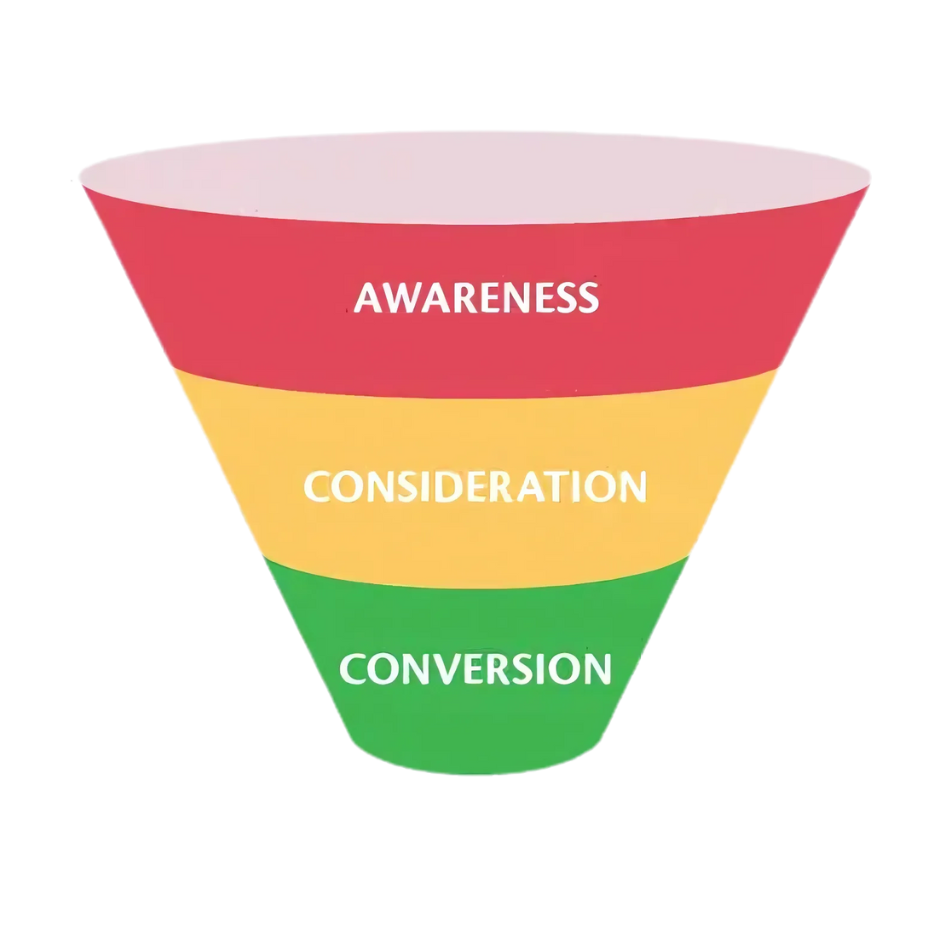
Connected Commerce
(How it’s going)
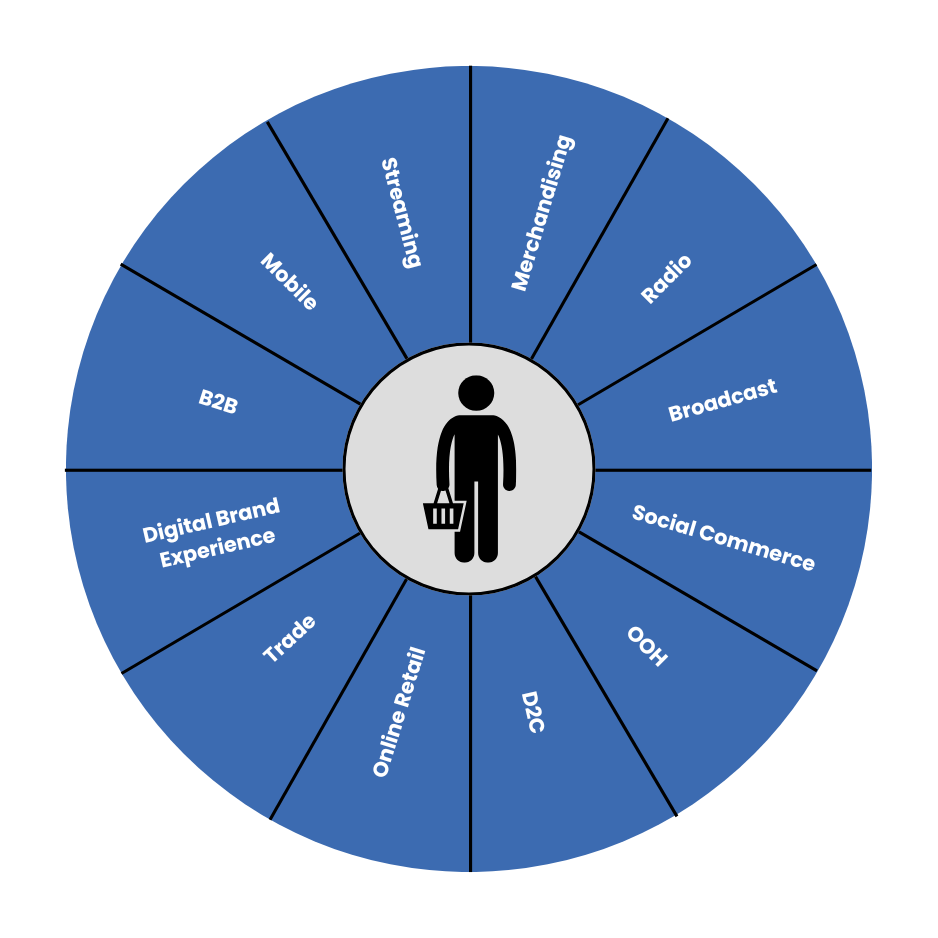
Consumer vs. Shopper
Simply put, a consumer is the user of a product, whereas a shopper is the chooser of a product. In the context of a sales funnel, consumers live at the top of the funnel and shoppers are further down.
Because of today’s shortened buyer’s journey, we generally consider the shopper and consumer as the same person. There are however exceptions – baby food for example.
Relevance at Retail: Why Shopper Marketing Matters
How does shopper marketing enable growth? The short answer is competitive advantage. For you visual learners, consider this recent photo featuring the barbecue aisle at a local St. Louis grocery store.
A couple quick things to point out:
- This photo represents about 2/3 of the entire barbecue sauce aisle
- In total, there are 20+ individual sauce brands and around 60-70 SKUs
- The eye-level shelf space (highlighted) is a store brand
From a retail marketing standpoint, most of these brands lack a clear competitive advantage. In the eyes of the consumer, those bottles are basically all the same.
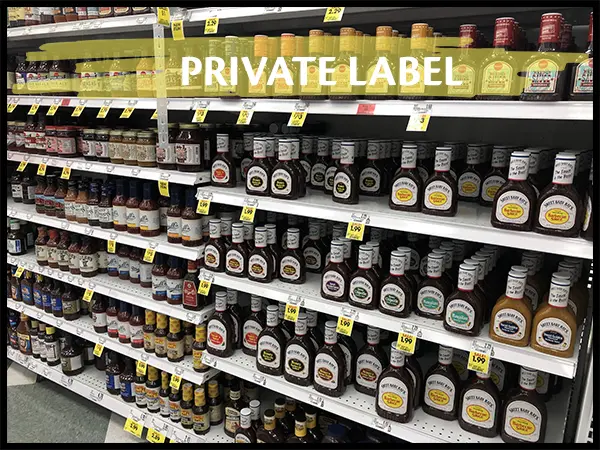
Let’s compare value using the 4 Ps of traditional marketing:
- Product: Each of the sauces have similar bottles, labels, ingredients, and brand messaging.
- Price: The private label brand has the best price point across the board.
- Promotion: Of the 45 SKUs shown, 36 of them are running a price promotion (yellow tags).
- Place: Sweet Baby Ray’s and the private label brand dominate the space.
In other words, only two of the 20+ brands clearly stand apart at shelf-level. The remaining 18 look the same, are priced the same, run the same promotions, and occupy the same space.
Here’s the point: CPG brands must look beyond the four walls of retail to gain a competitive edge. This is especially true for smaller brands that cannot compete against private label pricing or national brand notoriety. And now more than ever, smaller brands must reassess their strategy as consumers increasingly shift to private label.
3 Keys to an Effective Shopper Marketing Strategy
If you’re a CPG brand looking to move the needle in retail, there are 3 fundamental questions you need to answer:
- Why should consumers care?
- Why should shoppers buy?
- Why should retailers support?
Successful shopper marketing programs are built on value exchange. For instance, consumers aren’t going to sign up for your newsletter just because you ask – they want something in return.
In a similar sense, retailers won’t give you an incremental display because they like the color of your packaging. They want you to demonstrate how you’ll drive volume and elevate your category.
An effective shopper marketing strategy is able to create a triple win for the brand, the shopper and the retailer, that…
- Builds brand equity by capturing consumer interest
- Incentivizes the shopper and elevates the shopping experience
- Drives sales and margin at retail
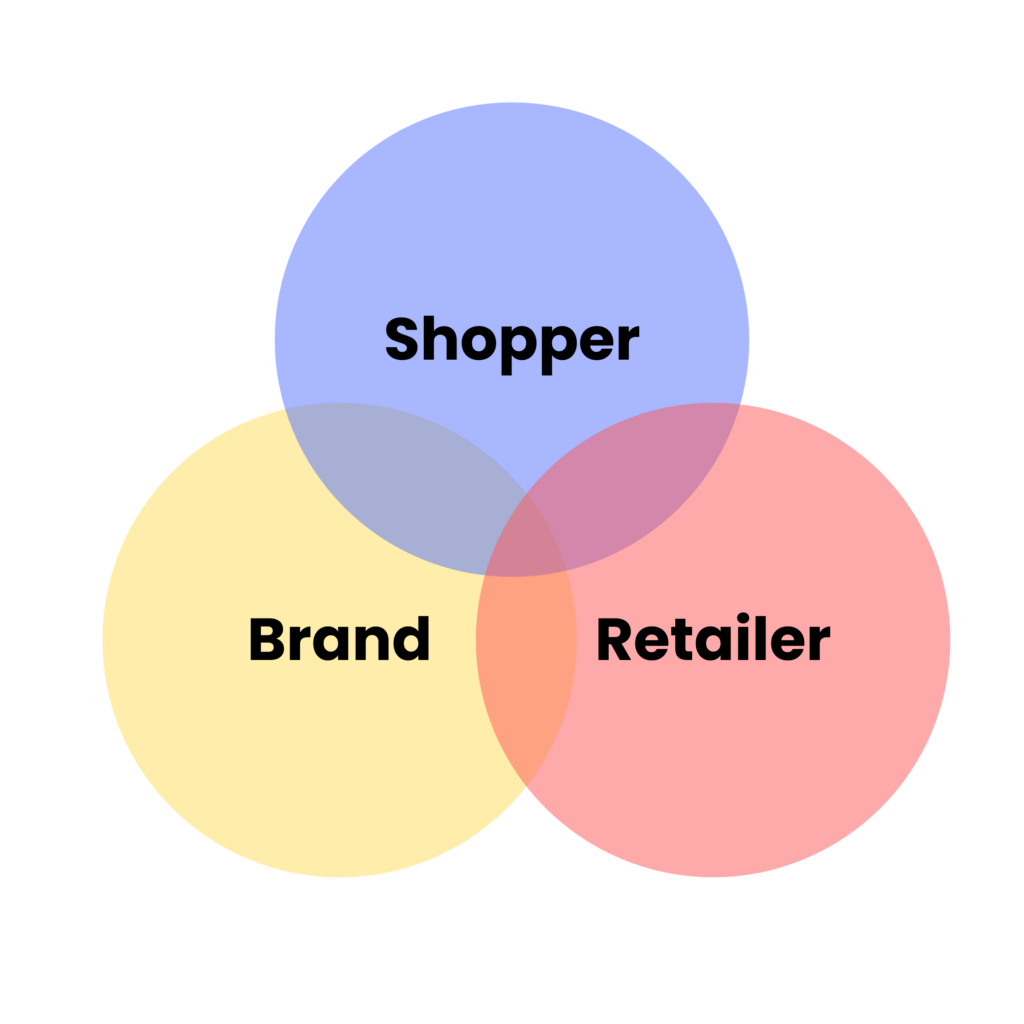
How to Create a Shopper Marketing Strategy
- Understand Shopper Behavior: Regularly update buyer personas and consumer journeys.
- Capture Consumer Interest: Use promotional hooks and a full-funnel experience.
- Incentivize Shoppers: Re-engage shoppers in “shopping mode” with relevant offers.
- Align with Retailer Goals: Solve problems that align with retailer strategies.
Understanding Shopper Behavior
To develop a shopper marketing strategy, you must first understand your target audience and the path they take to purchase. To do this, you need to:
This may sound like marketing 101 (and it is), but it’s also where most brands fall short – not because they don’t understand their customers per se, but because they set it and forget it. In other words, they don’t update their customer profile on a regular basis.
Understanding shopper behavior is not a one-time project, it’s an ongoing process. With so much data available today, it’s essential for brands to leverage that information to stay current with consumer preferences and industry trends. Collecting, managing, and translating data streams into actionable consumer intelligence will be crucial in the years to come.
But don’t just take my word for it – two-thirds of CPG companies say they have put data-driven marketing at the top of their agenda (source). In other words, your competitors are investing in data to make better informed decisions. Are you?
Capturing Consumer Interest
The first major question to address when developing a shopper marketing strategy is: why should consumers care?
For perspective, consider the fact that the average supermarket carries something like 47,000 products (source). That’s a lot of noise competing for your shopper’s attention.
Assuming you already have positioning in place, the goal here is to bring that message to life in a retail environment (i.e., Amazon, Walmart, etc.). To do this you need:
- A paid media / content distribution plan (which is covered in more detail below)
- A value exchange or promotional hook that pulls people into your campaign
When creating a “hook”, it’s important you consider the full-funnel experience. In other words, what happens after someone clicks? The marketplace is filled with sameness, and it’s hard to get people’s attention. But once you do, a solid brand / commerce experience can pay dividends.
A fun example is our recent Sunkist Mandarins campaign. As part of a brand refresh, Sunkist was rolling out new packaging & displays for California Mandarins. Their goal was to capture consumer interest and drive velocity at select retailers.
Our solution, and I’m paraphrasing, was a gamified brand experience that included mobile games, AR, and more.
Putting this in context, gamification was our promotional hook. It was our answer to the question, “why should consumers care?” And here’s why it worked:
- A mobile-first experience. As if you didn’t already know, 91% of consumers 18-49 buy things using their smartphones (source). Not only did a mobile-first approach cater to our core demographic (on-the-go moms), it also provided a shoppable platform to support a broader omnichannel effort.
- Multichannel Scalability. Retailers vary by scale, geographic, tactics, etc. We prioritized flexibility by using multiple content applications that could engage consumers across a wide variety of touchpoints. For instance, we offered retailers interactive quarter bins with dynamic QR codes. As needed, we could update the bins to feature different aspects of the mobile experience.
- A unique value-add. There are many ways to create value with consumers: coupons, content, contests. These are all tried and true but offer little differentiation. We took the path less traveled by creating a series of branded mobile games that could be used across multiple years.
- Proprietary Data. Finally, the experience was designed to be “sticky.” The more people engaged with the site, the more we could learn about them and create personalized content or offers around their interactions.
Incentivizing Shoppers
The second question to address when developing a shopper marketing strategy is: why should shoppers buy?
Having already piqued the interest of your target audience, your goal now is to re-engage them while in “shopping mode” (using Instacart for example). From a tactical standpoint, this means connecting high-level branding with lower-funnel activations (i.e., couponing, sampling, etc.).
When developing this “phase” of your strategy, there are a few things to consider:
Retail & Paid Media
In the context of shopper marketing, you should approach retail & paid media on an account-by-account basis. As mentioned, retailers vary by geography, scale, timelines, and preferred marketing tactics – customize your strategy accordingly.
As an example, here’s a screengrab from one of our strategy playbooks. We had to support multiple SKUs at multiple retailers, requiring multiple tactics, vendors, timelines and budgets.

The point is things can get very complicated, very quickly. Focusing on organization and clear communication between internal teams and agency partners is critical. Here’s an example of our approach to retail media planning & buying.
There’s a lot more to media buying that I won’t go into, but if you’re curious, here’s a few articles to check out:
- Unlock the Power of Paid Media for CPG and Retail Brands
- Maximizing ROI for Grocery Brands: The Essential Guide to Retail Media.
Instead, I’ve outlined some general guidelines / best practices for engaging shoppers further down the funnel:
- Keep it Stupid Simple: Make it easy for consumers to purchase everywhere you engage them. Your message should be clear and concise, and your commerce experience should be as frictionless as possible. It should only take 1 or 2 clicks to purchase.
- Use Price Promotions: Winning shoppers at the moment of buy often comes down to price. As mentioned, today’s consumers are more cost-conscious and less brand loyal than ever before. Make sure to anchor your marketing efforts with a price promotion, like a coupon or rebate, and give shoppers one more reason to buy.
- Experience Matters: Offer an exceptional experience through the sale and beyond. This may come as no surprise, but the service offered (or lack thereof) can make or break your brand. Make your experience extraordinary.
Data & Analysis
Many aspects of CPG marketing include some form of paid media support, but the further down the funnel you go, the more complex and costly it becomes. That’s why (as mentioned at the top) data management is so crucial to your shopper marketing strategy.
Ultimately, getting shoppers to buy comes down to delivering the right message, to the right audience, at the right time, on the right platform. Leveraging data is how you refine and optimize this process, so you can get the most bang for your buck.
Here’s some additional reading on data and performance marketing:
- How Performance Marketing Leads to Data-Driven Sales for Your CPG Brand
- Everything You Need to Know About Customer Data: Types, Collection and Analysis Strategies
Cross-Team Functionality
What good are data-driven insights if no one knows about them? CPG & retail brands are notorious for operating in silos – marketing vs. sales for example. But in the years to come, it will be increasingly important for companies to aggregate their data streams and seamlessly communicate that information across the organization.
Here’s a good article from McKinsey that addresses how CPG brands should approach data management and organizational structure.
Align with Retailer Goals
You’ve gained distribution in a few major retailers, congratulations! Now however, the hard part begins. Once you’re on the shelf, you need to move units or risk your buyer’s wrath. The question to ask at this point is, why should retailers support (your product / campaign)?
External tactics like social ads will only get you so far, and there’s still a disconnect between digital and physical retail (although that gap is closing). If you want to maximize your impact in store, you need the support of your retail partners. The benefit to your brand is 2-fold:
- Better placement like eye-level shelf space
- Promotional support like an aisle end display
How do you win favor with your retail partners? The short answer: you need to drive sales – for your brand, your category, and your retail partners. But in a competitive environment dominated by larger brands with deeper pockets, better brand recall, and more in-store real estate, how can you compete?
The key is to solve a problem that helps retailers meet their unique goals and strategies. As illustrated in the examples below, you can accomplish this through a top-down (brand led) or a bottom-up (retailer led) approach. Either way, what’s important is to marry your retailer’s strategic objectives with your own.
Example: Top-Down Approach
Based on feedback from their sales team, Sunkist discovered that certain key accounts needed a more flexible, engaging way to highlight produce during peak citrus season.
Based on brand messaging for each citrus varietal, we created 25 new displays and POS materials for the 2024 – 2025 citrus season. We developed the design and function of each piece by leveraging pulse moments in retail, incorporating shopper data, and conducting a sales team survey.
The result was a sleek, functional, and adaptable merchandising solution that could accommodate retailers of all shapes and sizes.
Here’s the full press release for more detail.
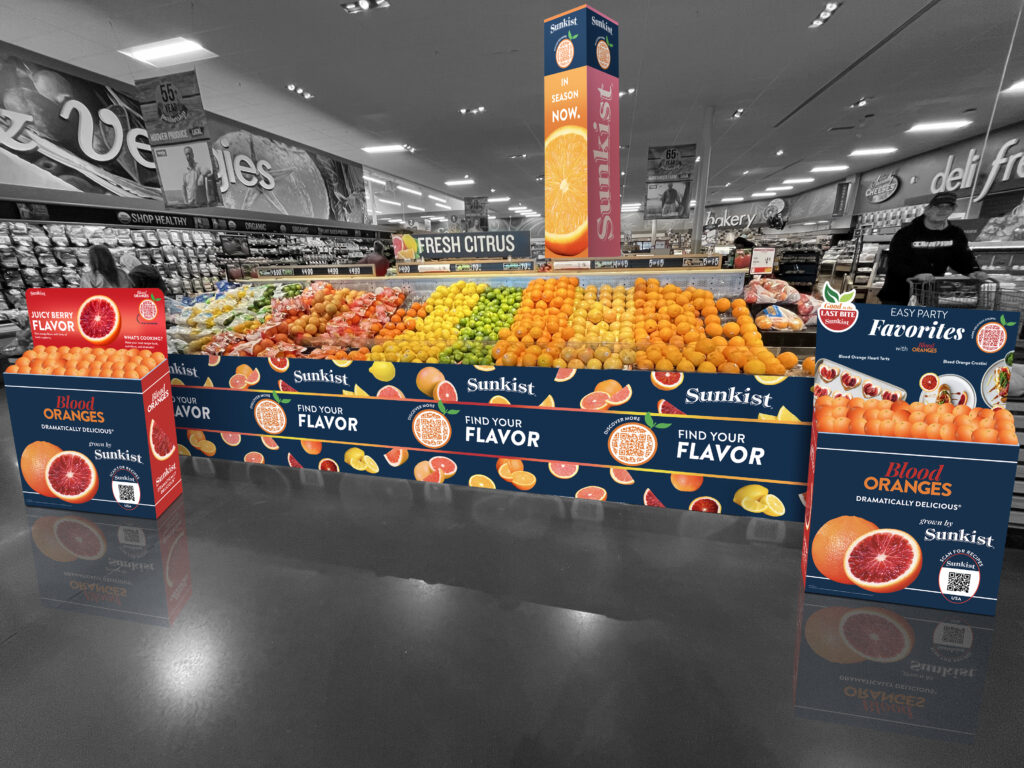
Example: Bottom-Up Approach
A few years back, we were approached by multiple CPG brands looking to move the needle in Walmart. Although each brand was different, we found common ground in the form of charitable giving. As it related to Walmart, that meant aligning with their mission to transform the cost and convenience of healthcare in the communities they serve.
Recognizing that 90% of the population is located within 10 miles of a Walmart, we set out to serve underserved communities by providing breast cancer education, on-site screenings, and donations to local breast health organizations.
For participating CPG brands, their support of a key Walmart initiative earned them aisle-end display space, pallet drops in action alley, and an average lift of 10-to-1.
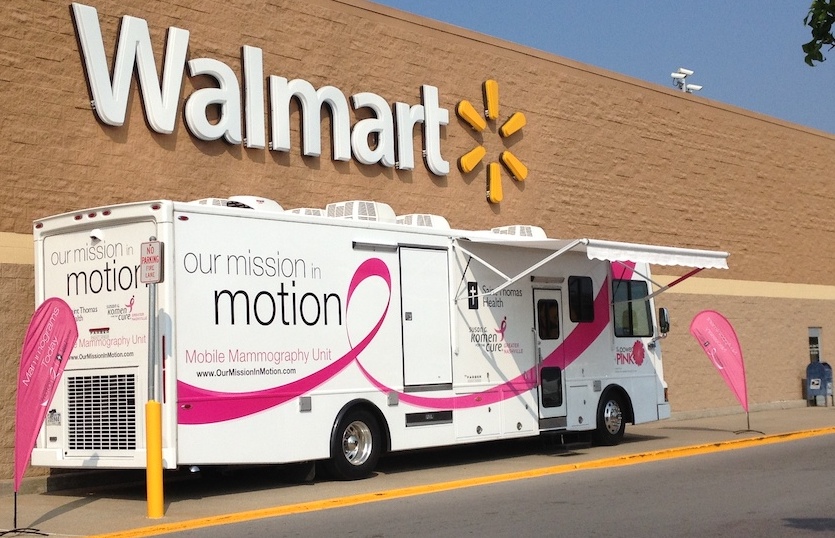
Drive Retail Success with Shopper Marketing
Shopper marketing is essential for CPG brands to stand out and drive sales in today’s competitive retail landscape. By leveraging data-driven insights, engaging consumers across omnichannel touchpoints, and aligning with retailer goals, brands can create a powerful triple win that benefits all parties involved.

